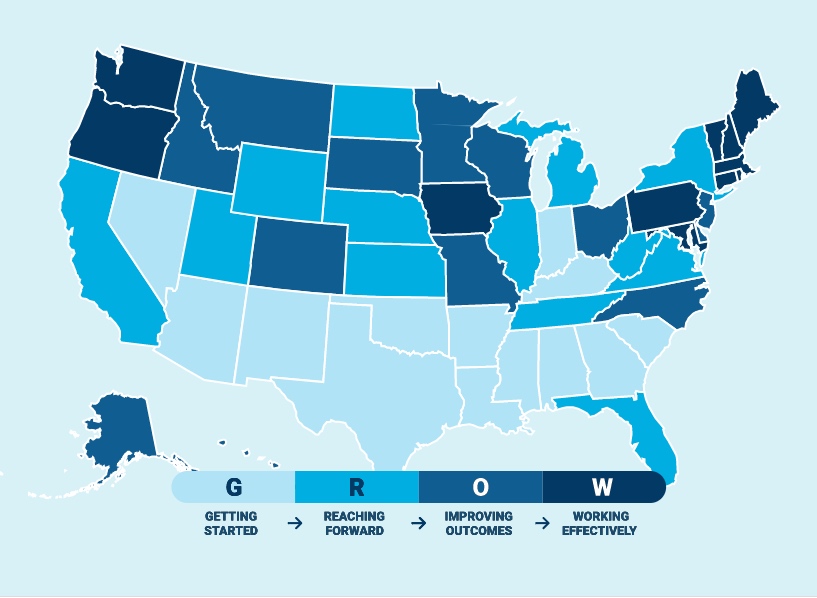Zero to 3: State of Florida babies not good
- June 23, 2020
- / Shannon Nickinson
- / early-learning

The state of babies in Florida has a long way to go.
That is the upshot of findings and analysis by the Zero to 3 Foundation in their annual “State of Babies” yearbook, released earlier this month.
Zero to 3 is a resource and advocacy group that focuses on improving outcomes for children in the first three years of their lives.
Their 2019 “State of Babies” Yearbook ranks states on metrics that are indicators for healthy, happy, thriving young children and some basic public policy uses that can help families at risk get to a better spot for their children.
The yearbook rates states on a four-part scale: Getting Started, Reaching Forward, Improving Outcomes, Working Effectively.
Florida is rated Reaching Forward. Because Florida, like many states across the South and Southwest, has a long way to go to becoming a place where babies and toddlers thrive. Explore the state-level data at this link. https://stateofbabies.org/states/
To grow and thrive, Zero to 3 says, babies need three basic ingredients: Good Health, Strong Families and Positive Early Learning Experiences.
Six indicators of Good Health: Infant mortality rate, uninsured/low-income infants and toddlers, late or no prenatal care received, preterm births, low-birthweight babies, ever breastfed.
The indicators for Strong Families: Family Resilience (income level), TANF benefits receipt among families in poverty, Crowded housing, Infant/ toddler maltreatment, Time in out-of-home placement, 2 or more Adverse Childhood Experiences (ACE).
Indicators for a Positive Early Learning Experience: Parents read to baby every day, developmental screening received, percentage of infants/toddlers who receive IDEA Part C services, Cost of care as a percentage of single-parent’s income, percentage of income-eligible children with access to Early Head Start, low/moderate income children in subsidized child care
Some of the metrics on the SCI Community Dashboard also appear in these metrics. Our dashboard aims to be a snapshot of the economic, educational and social well-being of our community. It is a mix of data points, developed in collaboration between SCI and the University of West Florida.
When it comes to children and families, the SCI Dashboard tracks:
Kindergarten readiness, percentage of students eligible for free- or reduced-price lunch, rent-burdened households, cost of childcare as a percentage of single-parent’s income, single-parent households, preterm birth rate and VPK participation rates.
You can check that data out here: https://www.studeri.org/community-dashboard
At 20 of our county’s 35 elementary schools, 50 percent or fewer students were ready for kindergarten in 2019. The disruptions to our world in the wake of COVID-19 will not make those figures better for the children who start kindergarten this fall.
Now is as good a time as any to invest in our youngest children. It may be the best chance we’ve come across to start making a real difference in our county’s future job prospects and quality of life.
Because that investment starts with making sure our 5-year-olds are literate, numerate and ready to learn. Last school year, only 47 percent of them were “school ready.”
We need to do better, or we will only ever be a mediocre community in a sleepy, seaside spot struggling to attract and retain the talent we need to grow our community, grow our tax base and improve our quality of life.
 CivicCon launches with a look at good growth in cities
CivicCon launches with a look at good growth in cities
 Building stronger brains one baby, one parent at a time
Building stronger brains one baby, one parent at a time
 SCI debuts commercial on Early Learning City
SCI debuts commercial on Early Learning City
 Entrecon: World class speakers and an opportunity to sharpen skills
Entrecon: World class speakers and an opportunity to sharpen skills
 PYP Quality of Life survey 2017
PYP Quality of Life survey 2017
 EntreCon Pensacola 2016: A look back
EntreCon Pensacola 2016: A look back
 Leadership tip: getting better employee takeaways
Leadership tip: getting better employee takeaways
 Leadership tip: be interested instead of interesting
Leadership tip: be interested instead of interesting
 Leadership tip: delivering difficult messages
Leadership tip: delivering difficult messages
 Brain Bags boost Arc, Early Childhood Court programs
Brain Bags boost Arc, Early Childhood Court programs